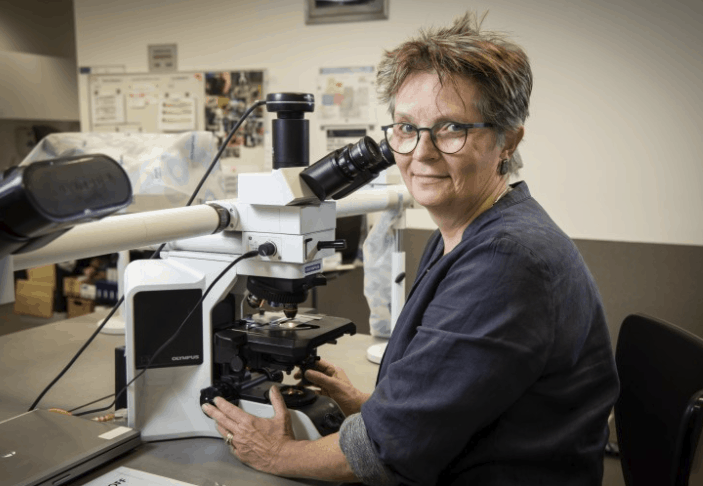
Dr Anne Peaston
Anne Peaston is an Associate Professor of Small Animal Medicine. She is a registered Specialist in Veterinary Oncology and a Diplomate in the American College of Veterinary Internal Medicine subspecialty of Oncology, and a Fellow of the Australian and New Zealand College of Veterinary Scientists.
Anne is the only Veterinary Oncologist in South Australia, and the Clinical Leader in the Companion Animal Health Centre (CAHC), School of Animal and Veterinary Sciences (SAVS), University of Adelaide. Here work here involves teaching, seeing clinical patients, and of course some research!
How long have you been working in veterinary research?
My research career started in 1989 with a case report of a dog with cranial vena cava syndrome, caused by a tumour growing into the cranial vena cava. My real introduction to clinical research followed, during my Oncology Residency training at the University of California-Davis (UCD) Veterinary Teaching Hospital where I ran two research projects on feline squamous cell carcinoma.
One was on pathology of the disease, and one used a new drug for photodynamic therapy, which we found provided long-term results about the same as other established methods.
This experience inspired me to take on a PhD program back in Sydney investigating a human childhood cancer, neuroblastoma. That work gave me the cell biology and molecular biology skills to undertake a wonderful research position at The Jackson Laboratory on beautiful Mount Desert Island in the northeast USA. The group I joined investigated at the molecular level how cells change from one thing to another in early development, working on very basic concepts of relevance to cancer formation. Back in Australia since 2011, I have continued to pursue basic and/or clinical research, mostly oncology or hematology-related, making the most of local opportunities and local and national collaborations. Two nationwide collaborations I am fortunate to be part of include VetCompass Australia (VCA) and ACARCinom. VCA collects electronic patient records from first opinion veterinary practices and makes the data available to investigate health problems in companion animals. ACARCinom is developing an Australia-wide registry of animal and complementary human cancers, an accessible comprehensive data asset for investigating the epidemiology of cancer in animals and humans.
Why did you choose this work?
I chose the field of work for a combination of reasons. The immediate reason was that my partner had been selected to undertake a 3-year residency training program at UCD and I was keen to undertake further training while we lived in California. My attention was caught by the high quality of the veterinary and comparative oncology training available at UCD, at the time led by Professors Bruce Madewell and Gordon Theilen. I asked whether I could join the program, and bottom-line answer was yes, but they could not pay me. After a year as an unpaid Oncology Resident, I was invited to join the group as a paid Resident. Yes, please! Another deeper reason for my choice is probably my experiences caring for my mother and grandmother at home in their final illnesses, both cancer. Compared with today, little was known about cancer in people and even less in animals although it was clearly a problem. I wanted to know more in order to help more.
What is your area of study and what do you hope to achieve?
My general area of study is basic and clinical veterinary oncology, branching out from time to time for example into haematology, and other areas. I like research work for the sense of discovering something interesting, sometimes unexpected, and sometimes useful and letting others know about it. Some of my work funded by ACAHF over the last few years has shed light on molecular changes in canine mast cell tumours of Australian dogs, with implications for treatment that warrant follow-up research. Three years ago, we identified a genetic mutation that causes congenital methemoglobinemia, a serious blood disease, in Pomeranian dogs. More recent evidence from others has shown that this is an international problem, and we are embarking on a genetic survey in Australia to discover the prevalence and mode of inheritance of the mutation.
What is your greatest research achievement with funding from ACAHF to date?
I have benefited from funding from ACAHF since the mid-1990s when I collaborated with Dr Jill Maddison on a project in which we showed that, in cats, doxorubicin as a sole agent to treat lymphoma had much lower efficacy than was predicted from work in dogs. The research achievements with mast cell tumours and Pomeranian dogs are, so far, the achievements of which I’m proudest. The mast cell tumour work identified, in a significant proportion of tumours, a genetic mutation that is likely to block the effectiveness of the drug toceranib, which is used for dogs with aggressive forms of the disease. This opens the way to better targeting this medication within that patient population. The work with Pomeranian dogs may enable breeding strategies to eliminate the mutation and the disease from the breed.
What is the biggest research challenge you have met with or continue to face?
The biggest challenge I face in combining all facets of my current roles is finding the time away from administrative obligations to attend to various research projects that we have in train. There are always at least two projects in the wings just waiting for the right student or interested veterinarian to take on!
What does the work of the ACAHF mean to you?
The work of the ACAHF is invaluable in providing funds for the support of higher degree by research students, research assistants, and research-active clinicians, either as salary supplements or for consumables, equipment, animal costs, and more. Over my years of reviewing ACAHF funding applications, I have been impressed by the number of great ideas and research plans submitted by colleagues from all corners of Australia. Together, I’m sure the evidence shows that the funded projects have made a tremendous practical difference to the lives of companion animals, in Australia and internationally as well.
